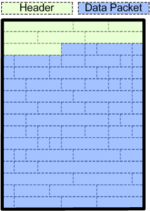Uwar overview
UWAR files (University of Washington - Activity Recognition) are a simple binary format that allows us to store data traces from multiple sources in a single format. The uwar file is composed of two main parts, a header, and a payload section that contains data packets. As illustrated in the figure on the right the header is always at the start of the file and contains:
- Meta data required for the uwar parser to understand the stream
- any additional meta data the stream wants to record (in its own format)
Once the header is written data packets are then written out to the file in a packetized format where there is a 'start' marker, some payload meta-data, (typically a timestamp), and the actual data payload.
The actual data that is written to the data section of the file is up to the stream's source. Some streams may only output relatively small packets while others may write large blocks of data (i.e. images, or sensor data). The actual contents of the data packet aren't known to the uwar writer however, in order to read the data out of the uwar file your parser must understand the data stored inside each data packet.
abstract.cs has a more detailed description of the packet format.
